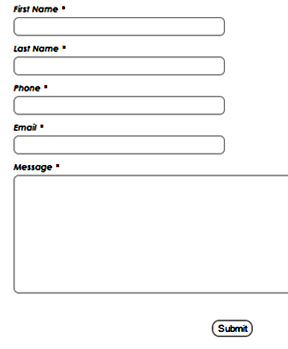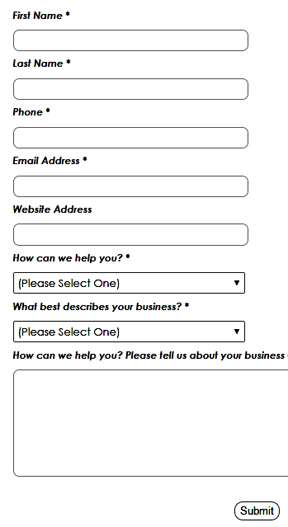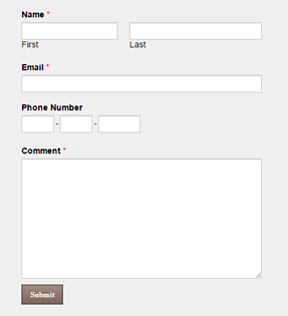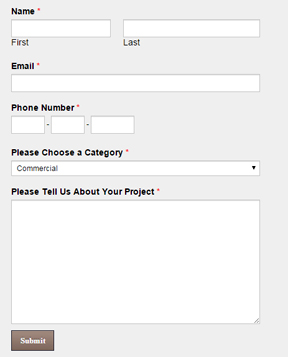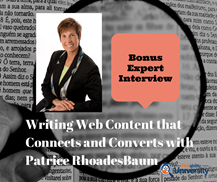Archive for the ‘Writing Tips (for websites, blog posts, speaker one-sheets, and more)’ Category
Write your website content: Start here / Start now (with this new coaching package)
Website copy must be on-target. Period. Do you know how to write your website content, s o it meets the mark?
o it meets the mark?
Is your website out-of-date, even embarrassing? Does it deliver qualified prospects – or does it just sit there, gathering dust? Have you been procrastinating, because you just don’t know where to start? Start here / start now, with my “Write Your Website Content” one-on-one coaching package.
As your most powerful marketing and sales tool, your website must work hard for you. It must:
- Present your brand and key messaging
- Ensure you shine as an expert in your niche
- Speak to your target market and address their needs
- Clearly state the results and benefits your clients get
- Build your list
- Deliver leads (qualified prospects)
- Sell your products and services
That’s asking a lot! So let’s start here…
With guidance, your website CAN do everything it needs to do. That’s why I offer an affordable “Write Your Website Content” one-on-one coaching package. In this 2-step coaching process, I’ll personally guide you to write on-target website content, whether you want to update your current website or create an entirely new website.
Step #1: Together, we’ll create your Website Roadmap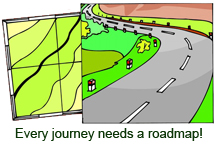
Every journey needs a roadmap! Your Website Roadmap clarifies where you want to go and how you’ll get there. This roadmap adds tons of clarity for you AND for your website developer. Believe me, having a clear plan lays the foundation for a streamlined, cost-effective, hassle-free website development process.
Step #2: With guidance, you’ll write your website content
Website copy is challenging to write, because it must:
- Be approached as marketing copy.
- Address navigation, usability, and other website-specific strategies.
- Emphasize benefits and results for your customers, rather than blandly discuss the business.
That’s why this coaching is so helpful – you get my personal guidance in one-one-one coaching calls, plus my proven tools. You’ll get the coaching, motivation, and the know-how to write your website content – copy that is clear and on-target. You’ll love this energizing process and the results you get!
“Write Your Website Content” one-on-one coaching package
Here are some of the tools and guidance you get:
- 1-hour one-on-one coaching call with Patrice to create your customized Website Roadmap
- Patrice’s personally created website content template, which offers the structure (and written advice) for how to write website copy
- Three 1-hour one-on-one coaching calls with Patrice (once a week for 3 weeks) regarding how to write your website copy: get direction, advice, answers to your questions, and a healthy dose of motivation!
- Bonus articles and videos include:
- “The power of clarity” (video)
- “Using the easy itch-and-scratch approach: How to write website copy and marketing content” (video)
- “How to create a project plan: Step-by-step instructions to get your project done” (a useful tool for your website writing project!)
- Patrice’s personal project plan template
- “Get qualified leads from your website by transforming your contact form into an inquiry form”
- “How to ask for (and get) client testimonials”
- “Checklist: How to edit testimonials to ensure they are professional and add value”
- “How to improve your writing: Patrice’s top 2 tips”
- “12-point checklist to systematically review your new or updated website before it goes live”
- Patrice’s preferred vendor list
This is a proven process to guide you to write your website content – clear and on-target copy that meets the mark. You’ll love this high-energy, results-oriented approach to write your website content!
Read More...
“Murder your darlings”: A writing tip for Halloween

“Murder your darlings.”
It’s not a Halloween joke. It’s a century-old, highly respected writing tip!
Who said it?
According to Forrest Wickman’s research, Arthur Quiller-Couch offered this insightful advice in his widely reprinted 1913-1914 Cambridge lectures “On the Art of Writing”:
“Whenever you feel an impulse to perpetrate a piece of exceptionally fine writing, obey it – whole-heartedly – and delete it before sending your manuscript to press. Murder your darlings.”
What does it mean?
Sometimes while writing, we create a sentence or paragraph that is particularly energetic. It flows! It sparkles! It may be brilliant!
But if that sentence or paragraph does not support your message, you need to kill it. You need to whip out your red pen or hit the delete key.
It breaks your heart, but it must be done.
I believe every word, every sentence must support the message. “Murder your darlings” reminds us to be objective when writing and editing our content.
We are servants of the message we seek to communicate. We cannot fall in love with a passage that does not serve our message.
I’ve been writing professionally for 30+ years, and I know it’s tough to “murder your darlings.” My advice? Take a breath. Buck up. Do it.
The more you “murder your darlings,” the easier it becomes. Your message is clear. Your writing improves. Everyone wins – except that “darling.” :>
Read More...
Writing tip: “Eat the big frog first”
What the heck does it mean to “eat the big frog first” – and what does it have to do with writing?
First, let’s look at this cryptic and confusing phrase!
Mark Twain said, “Eat a live frog first thing in the morning and nothing worse will happen to you the rest of the day.”
Over the past 100 years, this phrase has shifted to “eat the big frog first.” In other words, tackle the most challenging or dislikeable task first – or a big task that will produce your greatest results.
Now, let’s look at how you can “eat the big frog first” when writing articles, blog posts, or website content.
In this context, “eating the big frog first” means tackling the most difficult aspect of your writing project, right off the bat.
For example, if you’re creating all new content for your website, you would tackle the Home page copy first. This challenging chunk of copywriting can be difficult and daunting. Why?
Website Home page copy must:
- Convey your brand in a nutshell.
- Communicate your key benefit message.
- Be brief.
- Be on target (for your target market).
- Inspire the website visitor to keep reading, then contact you!
What if you don’t want to eat the big frog first?
Truth be told, I rarely eat the big frog first! I’ve been a professional copywriter for 30+ years. Often, I’ll start by writing smaller chunks of content. Editing a pile of testimonials. Compiling relevant notes to the project designer or developer. Later – when the creative juices are flowing – I’ll eat the big frog.
You can “nibble the little tadpoles first!”
Thanks to 2 recent conversations on this topic – with my client Debra and with my friend and marketing colleague Susan – we collectively coined the phrase, “nibble the little tadpoles first!”
Some people want to tackle the challenge right off the bat. These brave souls eat the big frog first. Meanwhile, some of us prefer to first nibble on little tadpoles to get the creative juices flowing.
Which approach is right for you?
There’s no right or wrong approach. As a professional copywriter, I encourage you to sink your teeth into your writing project and start by either eating big frogs or nibbling tadpoles.
One way or another, get started – and get that writing project done!
Read More...
SAVE THIS CHECKLIST: How to systematically review your new website before it goes live
Use this checklist to ensure a successful launch for your new (or updated) website!
 I’ve been a website marketing strategist, copywriter, and project manager “ever since Al Gore invented the Internet.”
I’ve been a website marketing strategist, copywriter, and project manager “ever since Al Gore invented the Internet.”
Over the years, I’ve reviewed hundreds of business websites to ensure they were polished, professional, and working properly.
Before a website goes live – and immediately after – I thoroughly review the website. Top to bottom. Using my systematic approach.
Use this checklist to thoroughly review YOUR new or updated website. The goal, of course, is to successfully launch your new, polished, professional website, so you can happily share it with the world!
Here’s my 12-point checklist. Use it to review your new or updated website before it goes live AND after it goes live.
- Test all links – Click the across-the-top navigation to ensure every web page is linked appropriately. Next, scroll down to the footer and click all text links to ensure they’re set up correctly, including social media icons. And don’t forget the site map: open the site map web page and check every link. Next, systematically move from web page to web page testing every link: any text links in the body copy, videos, audios, PDF speaker one-sheet, PDF resume, and all graphical elements (e.g., logos). If the blog has categories and a FeedBurner type of email subscription, check these links as well. Finally, on the interior pages, try clicking on the company logo in the banner – this should take you back to the Home page.
- Complete all forms to ensure they work – Complete all opt-in boxes and contact forms. Put on the “customer hat” and experience the process from the website visitor’s point of view. If there’s a PDF giveaway on the Thank-You-For-Subscribing page (from the opt-in box), click the link. It’s shocking how often this is overlooked! In fact, thoroughly review these behind-the-scenes thank-you pages (developers call these “success pages”). Also, critically look at any Captcha-type spam-control plugin the developer may have added to your contact form. Personally, I find reCAPTCHA beyond frustrating. If you and your website developer decide your website needs a spam-control plugin, select a version that your target market can easily use. Imagine a qualified prospect taking the time to thoroughly complete your contact form, then throwing in the towel due to a frustrating experience, right when they’re ready to hit Submit – you won’t get that lead.
- Now try to BREAK all forms! – What happens if you don’t complete a required field, then hit Submit? Is the “error” dialog box helpful? Or is it cryptic and confusing? On the contact form, can you input a long European phone number in the phone field or does it only allow 10 characters for US and Canadian phone numbers? Spend time trying to “break” every opt-in box and contact form. If there are any issues, it’s best for YOU to find them, not your customers.
- Purchase your product – Whip out your credit card and purchase your book or downloadable product. Check to ensure all pricing and shipping information is correct. Put on the customer hat to experience the purchase from the website visitor’s point of view. Is the purchase and downloadable process easy? Did it work properly? Are all directions throughout the process clear and easy to understand? Jot down any errors – and possible points of confusion – and discuss these with your developer.
- Test all email addresses – Is the main email address on the website Info@ABCcompany.com? Are there other email addresses? Ensure all are properly set up. If they don’t work, you may lose email messages from qualified prospects.
- Test all other features/functionality – Does your website have a search function? Test it. Any other features or functionality? Test these thoroughly, wearing the customer hat.
- Proof every word – Typos slip in … it’s a fact of life. Weirdly, typos seem to “hide out” best in 24-point headlines! Here are my favorite tips to flush out lurking typos and sneaky grammar and punctuation errors. This is an important step to ensure your website meets your high standards of professionalism.
(A) Print every page and proof the old-fashioned way – on paper. This simple trick offers a surprising level of objectivity and is much more effective than proofing at the monitor.
(B) Ask a family member, friend, or colleague to proof your website copy for you. Choose someone who has this skillset.
(C) Hire a professional proofreader.
~~~
~~~ - Critically examine stock photos – If the developer used stock photos in your new website, are the images fresh or trite? Do the images support your message? Ask pointed questions of your developer to ensure you have purchased the rights to use all stock photos and clipart. Finally, you’ll want to ensure photos with people present a mix of male/female, various ethnicities and, depending on your target market, different age groups.
- Check all redirects – For example, if your website address is ParagonConsulting.com and you requested that your developer redirect ParagonCoaching.com, then you’ll want to ensure this is set up.
- Ensure your developer has implemented basic SEO strategies – Like a well, this is a deep subject, given the plethora of SEO strategies and philosophies. At minimum, ensure your developer added a unique meta title and meta description for each web page and incorporated important organic keywords.
- Review using different browsers and multiple mobile devices (both Apple and Android) – Yikes, this is the bane of every website developer – and reviewers! This task can be time-consuming, and many developers do not conduct a thorough review. However, it’s YOUR website so, ultimately, it’s YOUR responsibility. At the time of this writing, there are 5 major browsers: Google Chrome, Mozilla Firefox, Internet Explorer, Safari, and Opera. Download each browser onto your computer and test the key features and functionality of your website on every browser (especially email and contact form). Yes, it’s a pain, but this is vitally important. And take time to review your new website on a variety of mobile devices – both Apple and Android. I recently found a significant issue when reviewing a client’s new website on my Android smartphone – an issue he didn’t encounter on his iPhone.
SIDE NOTE: As of December 2014, W3Schools.com listed the most popular browsers (in terms of market share) as:
- Google Chrome: 61.36%
- Mozilla Firefox: 23.6%
- Internet Explorer: 8.0%
- Safari: 3.7%
- Opera: 1.6%
- What’s missing? – I’ve done a ton of professional editing in my career. Long ago, this realization popped into my head regarding the difference between a proofreader and an editor: The proofreader looks at what IS there; the editor also looks at what is NOT there. Step up to the 10,000-foot level and ask yourself: “Is anything missing? Are all photos, videos, and other assets represented in my new website, as planned? Is the contact form robust, so it serves as a hardworking inquiry form? Have we overlooked anything?”
If you have thoroughly reviewed your new or updated website – using this checklist and a systematic approach – then you’re ready to go live. Congratulations!
Read More...
How do you get qualified leads from your website? Up-level your CONTACT form to an INQUIRY form
GET QUALIFIED LEADS. Clearly, this is a top goal for your business website.
In fact, from a marketing/sales perspective, most of us have 3 key goals for our website:
- Build the list with quality prospects
- Sell products and services directly via the website
- Get qualified leads from your website in order to sell products and services
Sometimes minor tweaks to your website can reap great rewards. One is transforming your basic CONTACT FORM into a hardworking, strategic INQUIRY FORM.
Use this checklist to get highly qualified leads:
- Have two different fields for First Name and Last Name (not just one field for Name).
- Ask for Email Address and Website Address.
- If you do business internationally, change the “Phone” field to “Phone/Skype.” Ask your website developer to ensure this field accepts numbers and letters, with room for at least a dozen characters.
- Add at least one question – with a drop-down list or radio buttons – that empowers the prospect to provide specific information that helps you qualify the lead. You may want to include multiple questions. For example, inquiry forms for professional speakers often request event date, location, and length; audience size and demographics; topic choice; and so forth.
- Make all important fields mandatory. However, if your form is lengthy, don’t make all fields mandatory. The prospect may lose interest and not complete the form.
- Make your Comment box work hard for you. Instead of asking for “Comments” or “Give us your feedback,” ask a direct question that encourages your prospect to provide useful information. For example, my inquiry form says: “How can we help you? Please tell us about your business – and how we can be of service.”
- When prospects hit “Submit,” they should automatically be taken to a thank-you page (aka Success Page). NOTE: Your prospects just took a BIG step forward in your relationship. You must ensure the content on this page is warm, friendly, and customized – not a basic template page with a skimpy, impersonal “thank you.” In your copy, add a note that you (or someone on your team) will follow up with a personal contact. On this page, consider adding: SEO keywords in the content, your scanned signature beneath a personal note, a photo to add warmth and personality, a prominent button/link to the Home page.
- Test your revised form to ensure the entire process works properly, including the fact that you (or your assistant) must receive an email notification with all information. NOTE: Thoroughly test your form by entering wrong information and intentionally making mistakes. Do the error messages work? Is the wording in the dialog boxes accurate and friendly – or cryptic and techie?
- Ask your developer to ensure the prospects’ names/email addresses are automatically added to your email database system: AWeber, Constant Contact, MailChimp, Infusionsoft, etc.
- Treat your qualified leads with the importance they deserve. Shockingly, some businesses do not have an efficient process to follow up on website-generated leads. They allow these valuable inquiries to gather dust. Meanwhile, those qualified prospects will go elsewhere to find the products and services they need.
Your website is your most powerful marketing tool. Yes, you want to get leads. Better yet, you want to get QUALIFIED leads from your website, via a hardworking and strategic INQUIRY form.
~ ~ ~ ~ ~ ~ ~ ~ ~ ~ ~ ~ ~ ~ ~ ~ ~ ~ ~ ~ ~ ~
Here are 2 examples where I have transformed a basic CONTACT FORM into an INQUIRY FORM.
Example #1 – Before and After
Example #2 – Before and After
Read More...
Idioms of the World
Ever wonder where those colorful – but cryptic – idioms come from?
- “It’s raining cats and dogs.”
- “She’s under the weather.”
- “He kicked the bucket.”
According to Merriam-Webster, idiom is “an expression that cannot be understood from the meanings of its separate words but that has a separate meaning of its own.”
My sister Karen, who also is a writer and word buff, forwarded a fun and informative article to me: “Idioms of the World.”
Written by London-based Matt Lindley and illustrated by Marcus Oakley, they explain the meanings of 10 wild and wacky idioms from around the world:
- Into the mouth of a wolf (Italian)
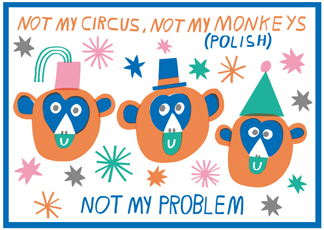
- Not my circus, not my monkey (Polish)
- To have a wide face (Japanese)
- To have the midday demon (French)
- To feed the donkey spongecake (Portuguese)
- A cat’s jump (German)
- To give someone pumpkins (Spanish)
- To ride as a hare (Russian)
- To let a frog out of your mouth (Finnish)
- To have a stick in your ear (Danish)
Curious? Click to read Marcus and Matt’s article: “Idioms of the World.”
Read More...
Shout-out to the Findability Profits Lab: My half-day workshop on website copy that helps you “get found”
Here’s a big THANK YOU to Heather Lutze and the participants of Heather’s October 2014 Findability Profits Lab.
During the 3-day Lab, I presented a half-day workshop on writing strategic, on-target marketing content for websites for solopreneurs and small business.
Heather asked me to present on the topic of website copy, since we both know from experience that writing, updating, and optimizing website content can be a sticking point for many solopreneurs and business owners. Unfortunately, this sticking point can slow or even halt progress on their website update.
If you’re looking to optimize your website – or “get found” as Heather says – I highly recommend Heather Lutze’s Findability Profits Lab.
Read More...
Marketing & Branding Views: Use the “Itch-and-Scratch” approach to write your marketing copy
THEME: Use the “Itch-and-Scratch” approach to write marketing copy
TIME: 2 minutes
LOCATION: Red Rock Canyon Open Space, Colorado Springs, Colorado
THE KEY VIEWPOINT: Use the time-tested and proven Itch-and-Scratch approach to write your marketing copy – especially website copy. And see what poison ivy looks like – remember, “leaves of three, let it be!”
CLICK HERE to read the transcript.
Read More...
Free webinar: “Writing Website Content that Connects and Converts”
Grab a pen and paper – get ready to take LOTS of notes!
In this webinar, my friend and colleague Heather Lutze, SEO expert and owner of Findability Consulting & Speaking, interviews me on the topic of writing website copy that connects and converts.
It’s a lively discussion with oodles of tips, tricks, and hints from us both. We offer guidance for you to write (or edit) website copy that connects with your target audience, is benefit rich, and contributes to search-engine optimization. The goal, as Heather says, is to “get found.” Along the way, there’s lots of laughter and a few myths dispelled!
Read More...
A must-read article on SEO
Last week, I got a phone call that rattled me.
“Wanda,” the sole marketing person for a small business, called to discuss the possibility of writing copy for her company’s new website. Typically, a small business website requires only 8 to 20 pages.
However, her SEO consultant advised creating a 75-page website!
Wanda’s company makes one product, with a wide variety of applications. In the proposed SEO strategy, about 60 web pages would have IDENTICAL content except for each page’s respective SEO keyword.
Why was this an issue?
- For Wanda’s business, creating the new website would be a huge investment of time and money.
- For the website visitor, this would be a navigation nightmare.
- And for the Google SEO robots visiting Wanda’s website? They could actually penalize the website!
I recommend this must-read article by SEO expert Marie Haynes.
Marie wrote this easy-to-read article for “the rest of us” – those of us interested in SEO yet not immersed in technicalities such as canonicals and crawl errors. (Click to read: http://tinyurl.com/olesugd)
The key point in Marie’s article…
More than ever, Google puts the emphasis on – and rewards – relevant, original, useful, pithy content. On the flip side, Google penalizes websites with tons of duplicate content, as in the example mentioned above. This is thanks to Google’s most recent, and sweeping, algorithm update, which they dubbed Hummingbird.![]()
No trickery. No gamesmanship.
When it comes to SEO strategies, content is king.
In addition to the advice in Marie’s article, here is my longstanding advice:
- In your web copy and blog postings consciously include organic SEO keywords. For example, if you are a speaker/consultant who speaks to and consults with Colorado-based healthcare organizations including hospitals and rehab clinics, then be sure to include these logical keywords.
- Whether you blog frequently or rarely, ensure your blog postings are relevant to your readers and contain original, useful information.
- What’s the right length for your blog postings? Be like Goldilocks! If it’s not too short or too long, it will be just right! (I shoot for 200-300 words.)
- Take time to clarify your brand so you can shine as an expert in your niche. (In Marie’s article, you’ll see that presenting yourself and your website as an “authority” on your subject is surprisingly important.)
- Focus on providing great content and advice for your real-live human readers. They will revisit your website – and so will the search-engine robots!

